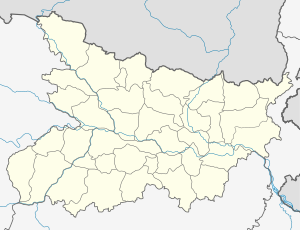Telhara, Nalanda district
Telhara is a village in Ekangarsarai block of Nalanda district, in Bihar, India. Renowned Urdu Poet from Bihar, Dr. Kalim Ajiz was born in this village, which is also his final resting place.During communal tension that arose out of division of India just after Independence, the Muslims migrated to other places to earn their livelihood. Dr Kalim Aziz was one among them. Mahatma Gandhi sent his special emissary Khan Abdul Gaffar Khan @Frontier Gandhi to visit the place and make efforts to bring harmony among the rival communities. The people of this place still repent the gory past. The annual Durga Puja festival (shardiya navratra ) is observed here with much fanfare and rural folk from far and wide gather here to worship the deity.
Telhara Telhāḍa | |
|---|---|
village | |
 Telhara Location in Bihar, India | |
| Coordinates: 25.226334°N 85.181587°E | |
| Country | |
| State | Bihar |
| District | Nalanda |
| Gram Panchayat | Ekangarsarai |
| Languages | |
| • Spoken | Hindi, Magadhi |
| Time zone | UTC+5:30 (IST) |
| PIN | 801306 |
| Vehicle registration | BR-21 |
| Nearest cities | Jehanabad (22 km) Bihar Sharif (35 km) Patna (63 km) |
History
Telhara was the site of a Buddhist monastery in ancient India. It has been mentioned as Teladhaka in the writings of the Chinese traveller Hiuen Tsang, who visited the place in the 7th century CE. It has been also mentioned in the Ain-i-Akbari as Tiladah, and is shown as one of the 46 mahals (administrative units) of the Bihar sarkar. Telhara was shown as a pargana in the maps prepared by the East India Company administration during 1842–45.[1]
The ruins of Telhara were mentioned in an 1872 letter by A. M. Broadley, the then Magistrate of Nalanda. The State Government of Bihar started a new archaeological excavation of the site in December 2009. The work unearthed ancient pottery, antiques, and the remains of a three-storeyed structure mentioned by Hiuen Tsang. Evidence of prayer halls and residential cells in the monastery have been found. The excavation revealed the following chronological layers:[1]
- Northern Black Polished Ware (3rd Century BCE)
- Kushan (1st century CE)
- Gupta (5th to 7th century CE)
- Pala (7th century to 11th century CE)
A number of sculptures from the site had been moved to museums during the British Raj. The Indian Museum in Kolkata houses the Maitreya and the twelve-armed Avalokiteswar images from Telhara. A Pala sculpture from the site is present at the Rietberg Museum in Zurich. Telhara has a mosque, which is said to have been built with the materials carried from the ruins of the Buddhist monastery.[1]
Remains of an ancient university (Mahavihara) on the site were unearthed in 2014.[2][3]
Administration
Telhara comes under the administration of the Ekangarsarai gram panchayat. There are 5 census villages in the Telhara area:[4]
- Hajipur
- Khajepura
- Rasulpur
- Telhara
- Telhara Sani
References
- Dr. Atul Kumar Verma. "Telhara (Nalanda) Excavation - A Brief Report (PDF)" (PDF). Retrieved 15 January 2014.
- http://timesofindia.indiatimes.com/city/patna/Another-ancient-university-found-in-Nalanda/articleshow/28807538.cms
- "Telhara university".
- "Reports of National Panchayat Directory". Retrieved 15 January 2014.